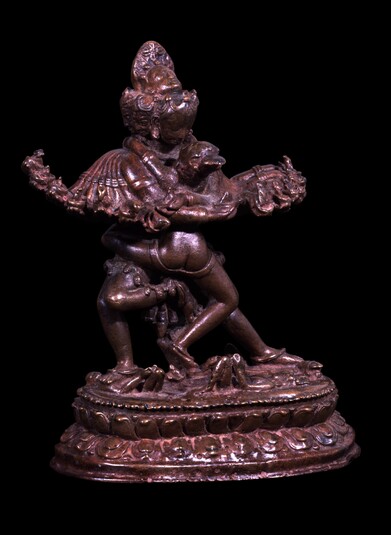
Item: Hevajra (Buddhist Deity)
| Origin Location | Nepal |
|---|---|
| Date Range | 1100 - 1199 |
| Lineages | Sakya and Kagyu |
| Size | 19.69cm (7.75in) high |
| Material | Bronze |
| Collection | Rubin Museum of Art |
| Catalogue # | acc.# P2000.8.3 |
Classification: Deity
Shri Hevajra (Tibetan: pal gye pa dor je) the principal deity of the Sakya School and the tutelary deity of Marpa the Translator, founder of the Kagyu School.
Sanskrit: Hevajra Tibetan: Gye pa dor je
Tibetan: Gye pa dor je
Semi-wrathful, with eight faces, sixteen hands and four legs, at each side of the main face are three further faces with the eighth situated centrally above. the hair flows upward like flame from each of the heads. Skullcups are held in sixteen hands. The eight on the right hold various animals looking inward and the eight on the left hold the eight worldly gods gazing outward. The first pair of arms folded at the heart embrace the consort. Adorned with a crown of five skulls, bone ornaments and a necklace of fifty freshly severed heads he has the appearance of being slightly wrathful and slightly peaceful. The consort Vajra Nairatmya has one face and two hands. In the upraised right she holds a curved knife. Adorned with a tiara of five skulls, a necklace of fifty skulls and bone ornaments, she is supported by the left leg with the right embracing Hevajra. Standing on three legs with one drawn up, he is in a dancing stance atop the forms of four Hindu gods, above a lotus seat.
"...Shri Hevajra with a body blue in colour, eight faces, sixteen hands and four legs. The main face is blue, right white, left red, upper face smoky; the two remaining pairs of faces are black. Each face has three eyes and four bared fangs; yellow hair flowing upwards; the top of the head is marked with a vishvavajra. The sixteen hands hold sixteen skullcups. The first right holds a white elephant, the first left holds the yellow God of Earth; these two embrace the Mother. In the second right is a blue horse; third - ass with a white patch; fourth - yellow bull; fifth - ash-coloured camel; sixth - red man; seventh - blue sharabha; eighth - cat with a white patch. In the second left hand is the white God of Water; third - red God of Fire; fourth - green God of Air; fifth - white God of the Moon; sixth - red God of the Sun; seventh - blue Yama; eighth - yellow Holder of Wealth. Each head has a crown of five dry human skulls; and a necklace of fifty fresh heads; six bone ornaments; the two right legs are extended, on the thighs the toes of the two folded left legs are pressing in the half-[vajra] posture in a dancing manner; possessing the nine sentiments of dancing: grace, strength and ugliness; laughter, ferocity and frightful; compassion, fury and peace. In the lap is the mother Vajra Nairatmya, with a body blue in colour, one face, two hands, three eyes; yellow hair flowing upwards; right a curved knife, left holding a skullcup and embracing the father; five dry human skulls as a crown; a necklace of fifty dry [skulls]; five bone ornaments; left leg extended and the right drawn up embracing the father. Both are standing in the middle of a blazing fire of pristine awareness." (Ngagwang Legpa).
"...in the east black Gauri, right hand holding a curved knife, left a rohita fish; south red Chauri, right hand holding a damaru, left a pig; west yellow Vetali, right hand holding a tortoise, left a skullcup; north green Ghashmari, right hand holding a snake, left a skullcup; north-east blue Pukkashi, right hand holding a lion, left an axe; south-east white Shavari, right hand holding a monk, left a monk's staff; south-west purple Chandali, right hand holding a wheel, left a plough; north-west multi-coloured Dombini, right hand holding a vajra, left a wrathful gesture. Also, all have one face, two hands, three eyes and yellow hair flowing upward; naked, adorned with five ornaments of bone; a crown of five human skulls and a necklace of fifty skulls. With the left leg extended and the right in a half-lotus posture, in a dancing manner, they stand in the middle of a blazing fire of pristine awareness." (Konchog Lhundrub).
According to the Kagyu system of tantra classification Hevajra belongs to the 'Wisdom-mother' Anuttarayoga tantra. According to the Sakya system Hevajra belongs to the 'Non-dual' Anuttarayoga. From the various forms of Hevajra this figure is known as the 'Essence Hevajra' as taught in the root Tantra of 'Two Sections.'
Distant Indian Lineage: Vajradhara, Jnana Dakini, Bodhivajra Garbha, Arya Nagarjuna, Aryadeva, Chandrakirti, Matangipa, Tailo Prajnabhadra (Tilopa), Naro Jnana Siddhi (Naropa), etc.
Jeff Watt 3-2002
Buddhist Deity: Hevajra Sculpture (Masterworks)
Sculpture: Metal
Nepal: Sculpture (All)
Buddhist Deity: Hevajra Main Page
Sculpture, Metal: Buddhist Deities
Collection of RMA: Selected Sculpture
Nepal: Early Malla Period Sculpture
Buddhist Deity: Hevajra (Sculpture)
Collection of Rubin Museum (Nepalese Sculpture Masterworks)
Buddhist Deity: Hevajra (Early Sculpture)
Buddhist Deity: Hevajra Art History
Buddhist Deity: Hevajra (Best Examples, Sculpture)

